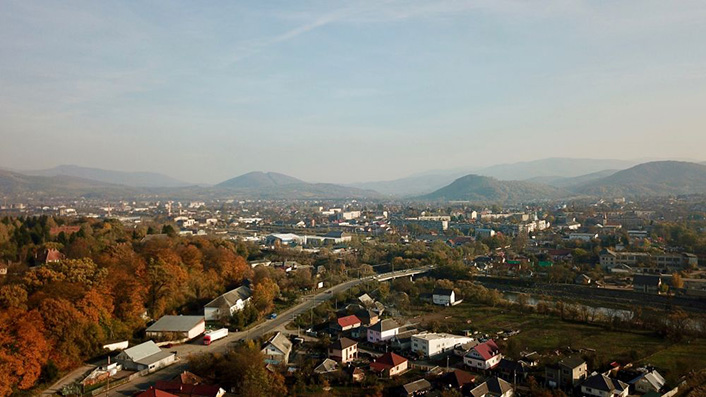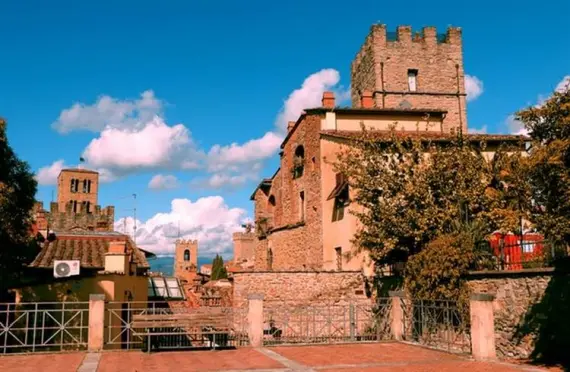Coach SVALYAVA - AREZZO - find a connection and buy a ticket
SVALYAVA

Svalava (ukr. Свалява), a city in western Ukraine, Transcarpathian region, located in the valley of the Latoritsa River. It is a small city with a rich history and a unique location that makes it an important center in the Transcarpathian region.
Svalava's economy is based mainly on agriculture and tourism. The city lies in the picturesque region of Transcarpathia, which attracts tourists, especially those interested in mountain and ecological tourism. The region is home to numerous vineyards, as well as animal husbandry, especially cattle and sheep.
Svalava is also home to a thriving food industry, handicrafts and small-scale manufacturing. Although the city is not one of Ukraine's major industrial centers, it is an important point on the economic map of the Transcarpathian region.
Svalava is located in the northeastern part of the Transcarpathian region, about 50 kilometers southwest of Uzhhorod, the region's capital. The city is well connected to major centers in the region, and its proximity to the borders with Hungary and Slovakia makes Svalava an important point on the cross-border map of Ukraine.
The city is a place where different cultures meet, including Ukrainian, Hungarian and Slovakian, which influences local traditions and daily life. Svalava residents cherish their cultural heritage, organizing festivals, exhibitions and other events that attract tourists.
The region is also home to a number of religious buildings, which testify to the multicultural character of Transcarpathia. There are also local fairs and markets in and around Svalava, where handicrafts and traditional products can be found.
Svalava (ukr. Свалява), a city in western Ukraine, Transcarpathian region, located in the valley of the Latoritsa River. It is a small city with a rich history and a unique location that makes it an important center in the Transcarpathian region.
Svalava's economy is based mainly on agriculture and tourism. The city lies in the picturesque region of Transcarpathia, which attracts tourists, especially those interested in mountain and ecological tourism. The region is home to numerous vineyards, as well as animal husbandry, especially cattle and sheep.
Svalava is also home to a thriving food industry, handicrafts and small-scale manufacturing. Although the city is not one of Ukraine's major industrial centers, it is an important point on the economic map of the Transcarpathian region.
Svalava is located in the northeastern part of the Transcarpathian region, about 50 kilometers southwest of Uzhhorod, the region's capital. The city is well connected to major centers in the region, and its proximity to the borders with Hungary and Slovakia makes Svalava an important point on the cross-border map of Ukraine.
The city is a place where different cultures meet, including Ukrainian, Hungarian and Slovakian, which influences local traditions and daily life. Svalava residents cherish their cultural heritage, organizing festivals, exhibitions and other events that attract tourists.
The region is also home to a number of religious buildings, which testify to the multicultural character of Transcarpathia. There are also local fairs and markets in and around Svalava, where handicrafts and traditional products can be found.
AREZZO

What to see when visiting Arezzo? Sights not to miss are the majestic Church of Santa Maria della Pieve, located in Piazza Grande, with its distinctive 4-story facade, and the Cathedral of St. Peter and St. Donatus, full of beautiful frescoes. Also worth seeing is the basilica of San Francesco, built at the end of the 13th century and full of 14th-century paintings and frescoes, including those by Piero della Francesca, as well as the Gothic basilica of San Domenico from the turn of the 13th and 14th centuries, with equally valuable paintings and sculptures. Arezzo also has Roman-era monuments, such as the ruins of an amphitheater from the 2nd century AD, as well as interesting museums full of exhibits and picturesque parks.
Getting to Arezzo - bus, car, plane or train?
Arezzo is located 80 kilometers from Florence and 120 kilometers from Perugia. The nearest international airport is in Florence, although from Poland it is easiest to fly to Rome and from there take a train or bus to Arezzo. The route by car from Warsaw takes about 18 hours of driving. Consider a direct bus ride from the many Polish cities we offer to Arezzo. Our buses stop at via Bernardo Rossellino, near the city's main train station.
If you are interested in the description of the city and want to include Arezzo in your vacation plans , you can find a bus at a convenient time in the search engine on the home page. Feel free to board our buses!
What to see when visiting Arezzo? Sights not to miss are the majestic Church of Santa Maria della Pieve, located in Piazza Grande, with its distinctive 4-story facade, and the Cathedral of St. Peter and St. Donatus, full of beautiful frescoes. Also worth seeing is the basilica of San Francesco, built at the end of the 13th century and full of 14th-century paintings and frescoes, including those by Piero della Francesca, as well as the Gothic basilica of San Domenico from the turn of the 13th and 14th centuries, with equally valuable paintings and sculptures. Arezzo also has Roman-era monuments, such as the ruins of an amphitheater from the 2nd century AD, as well as interesting museums full of exhibits and picturesque parks.
Getting to Arezzo - bus, car, plane or train?
Arezzo is located 80 kilometers from Florence and 120 kilometers from Perugia. The nearest international airport is in Florence, although from Poland it is easiest to fly to Rome and from there take a train or bus to Arezzo. The route by car from Warsaw takes about 18 hours of driving. Consider a direct bus ride from the many Polish cities we offer to Arezzo. Our buses stop at via Bernardo Rossellino, near the city's main train station.
If you are interested in the description of the city and want to include Arezzo in your vacation plans , you can find a bus at a convenient time in the search engine on the home page. Feel free to board our buses!
© 2025 Sindbad
Technical support, assistance, payments: Sindbad IT
© 2025 Sindbad
Technical support, assistance, payments: Sindbad IT
